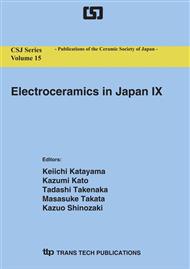p.15
p.19
p.23
p.27
p.31
p.35
p.39
p.45
p.49
Electrical Properties of Grain-Oriented SrBi2Nb2-xVxO9 Ceramics
Abstract:
Vanadium-substituted strontium bismuth niobate, SrBi2Nb2-xVxO9 (SBNVx), ceramics were synthesized by a low-temperature ceramic fabrication process; their electric properties were characterized, and grain orientation effects on their electric properties were also investigated using a hot-forging (HF) method. Resonance characteristics of the (33) and (15) modes of grain-oriented SBNV0.1 (HF) showed relatively high electromechanical coupling factors of k33=0.272 and k15=0.151 as well as piezoelectric constants of d33=31.7 pC/N and d15=24.8 pC/N. The temperature dependences of the resonance frequency (TC-f) of the (33) and (15) modes of the SBNV0.1(HF) ceramics were -16.5 ppm/°C and –25.5 ppm/°C, respectively.
Info:
Periodical:
Pages:
31-34
Citation:
Online since:
September 2006
Authors:
Price:
Сopyright:
© 2006 Trans Tech Publications Ltd. All Rights Reserved
Share:
Citation:


